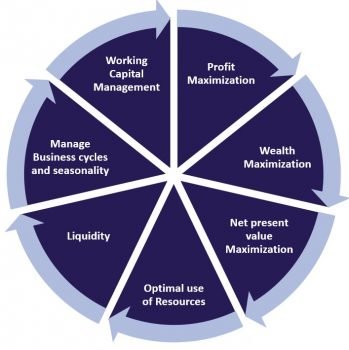Thinking why your business is yet to turn profitable? Try deep diving to know if the financial management practices you follow are compliant with the objectives of financial management? Financial management is mainly concerned with managing overall financial activities in the most optimal way to maximize your profits while mitigating risks at all levels. It is the art of managing money. The success or failure of any business is hugely dependent upon how well your finances are managed.
Table of Contents
What is Financial Management?
Financial Management is the art of planning, allocating resources, controlling, investing, funding, monitoring, and managing funds of a business enterprise. All the financial decisions are part of this activity. Profitability and Liquidity are the most sought-after objectives of financial management. Financial Managers are hired to manage the financial affairs of the business and meet all the expressed objectives of financial management.
Financial management roles are highly paid like those of financial managers, financial advisors, financial analysts, fund managers, credit managers, collection managers, strategy development managers, and the list goes on. With the growth in demand for financial management functions, the financial management jobs are right to bet now, and in the future.

The Objectives of Financial Management
Managing Finances will not serve any purpose if not done right. Compliance with the objectives of financial management is important to achieve short-term and long-term goals. Below are the explicit details about the objectives of financial management:
One of the basic objectives of financial management is to understand the revenue and cost structures related to all the processes, and then identify those which are profitable. Rank them in descending order based on the profit margins, and then concentrate on those whose profitability could be increased by adopting cost control strategies. Also, generate a list of those processes which are into losses, and start identifying ways to turn them profitable. When this process is repeated, the long-term profitability of the business increases. Surplus so generated may serve various purposes like funding, expansion, process improvements, conducting research and development for innovations, etc.
2. Wealth Maximization
Again, one of the basic objectives of financial management is to maximize the owner’s wealth. People who are the owners or have invested in the business should reap higher profits. Maximizing the net present value of the invested amount is the aim to be achieved. This is also known as Value Maximization or Net Present Worth Maximization. It is almost universally accepted as a more appropriate decision criterion. This is important as those who have their skin in the business need to get compensated for undertaking the risk. Capital appreciation in the form of an increase in the market value of shares will fetch them the desired returns.
It considers both quality and quantity dimensions of benefits and also incorporates the time value of the money concept. Adjustments are required to be made in the cash flow patterns to include the risk element and make allowance for differences in the timings of benefits. Discounting method is most popularly used in these cases. Cash flows generated from a set of decisions taken should be focused upon rather than the accounting profits. Let us summarize the overview of this objective below:
- Maximizes the net present value of investments to stakeholders
- Accounts for the timing and risk of the expected benefits.
- Measure benefits in terms of cash flows
- Maximize the market value of the firm’s shares
3. Optimal use of Resources
Identifying optimal equipment usage with ideal volume production would ensure optimal use of resources be it raw material, labor, electricity, etc. No wastage policy helps in reducing unwanted costs. Diverting resources from less profitable processes to more profitable processes also helps in optimal allocation and usage of resources.
4. Liquidity
Liquidity helps in absorbing any unexpected shocks. Any natural calamities like floods, covid-19, theft, fire, etc. need to be taken care of, inclusive of having immediate funds. Thus, liquidity becomes one of the topmost objectives of financial management to which the firm should be compliant. Uncertainties trigger risk, and liquidity is required to handle any of such uncertain situations or risks. Financial management involves keeping everyone aware of any contingent liabilities which might take place. To meet them contingent reserves should be created which provides quick liquidity.
5. To manage Business cycles and seasonality
Be it inflation or recission, growth or maturity stage, financial management becomes critical to handle finances of any business. Arranging short-term finances to meet the peak seasonal requirements is vital to be able to meet the current obligations. Temporary shortages of funds would also have a huge impact on any business. Managing inventory, work in progress, controlling costs, investment decisions all combining help in meeting these cyclical fluctuations. Forecasting helps in monitoring all the key metrics.
6. Working Capital Management
Working capital is the difference between current assets and current liabilities. Short-term and long-term financing of working capital helps the firm to meet its short-term and long-term liabilities. All these long terms & short-term sources of working capital serve the purpose of bridging the gap between supply & demand. These are vital for the efficient functioning of any firm.
7. Expansions and product developments
Continuous growing business survives in the long run. Continuous expansions and diversifications are possible through an adequate amount of funding. These fundings if are self-funded then nothing’s like that. Financial management will help to reserve a portion of your surplus for future expanding purposes. Opening a new store in a different location or adding a product line to your business product mix, or providing additional service to the consumers. All require funding as expenses occur if you add on to your business portfolio.
8. Meet Audit and Compliances
The business has to follow various rules and regulations of the state and country where it is located. Taxation, employee welfare, audit compliance, filling returns on time, environmentally friendly rules everything has to be considered. Financial management will help businesses to adhere to all such policies and also fulfill all the legal obligations on time, to avoid any last-minute rush or penalty situation.
9. Social Welfare Activities
Stress on Corporate Social Responsibility for a business in today’s world is the foremost priority. Besides the business gets tax benefits and brand exposure by undertaking such CSR activities. Welfare programs like child education, providing relief funds for natural calamities, and funding NGOs, would help to contribute to society. Monetary contributions are not mandated in fact non-monetary contributions toward society will also go a long way in building a good brand image. This would boost brand loyalty and goodwill.

The above 2 objectives of financial management, profit maximization, and wealth maximization are the most important among all. These 2 approaches have their own advantages as well as disadvantages. Let us go through them briefly:
Advantages of Profit Maximization objective
- Profit is a yardstick against which the operational efficiency of a business is measured. Thus, the profit maximization technique will help in achieving operational excellence
- Risk mitigation at all levels is possible only if the business becomes profitable. As profitability helps businesses in expansion, facing uncertainties. Risk is minimized to a great extent.
- Social Welfare can take place only when a business has earned sufficient profits to spare.
- Profits are required for improving the quality of products or services offered to the consumers. Funds are required to undertake research and development activities.
Disadvantages of Profit Maximization objective
- It is unclear about the time period whether profit earned in short term or in long term is the focus.
- The time value of money is completely ignored. The cost of inflation is not considered while calculating absolute profits.
- Risk in terms of uncertainties is given more stress, while risks both internal and external might trigger in various forms.
- Only monetary value is given importance while ignoring all the non-financial important parameters
Advantages of Wealth Maximization objective
- It considers the time value of money. All the calculations done reflect the true value after considering various cost adjustments
- The inherent risk in any business is stressed upon
- It safeguards the interest of all the stakeholders
- Concentrates on increasing the shareholder’s wealth. It passes on the benefits through dividends and capital appreciation from time to time.
- Aims at a long term perspective
Disadvantages of Wealth Maximization objective
- Usually suitable for large corporates and organizations
- May take reinvestment plans more seriously than distributing dividends to the shareholders
Which of the two objectives of financial management, profit maximization, and wealth maximization is better and more logical?
Wealth maximization objective wins hands down because of the below reasons:
- Wealth maximization is nonambiguous and very specific
- It strikes a balance between risk and returns
- It considers the time value of money
- It safeguards the interest of all the stakeholders
Scope of Financial Management
It starts with the understanding of the discipline, the financial activities involved in a firm, how are they related to the firm’s other activities, and so on. Basically, the discussion on the scope and function of financial management is divided into two broad categories for convenience:
- Traditional Approach
It is more like Corporate Finance as far as the subject matter is concerned. The concern of Corporate Finance was with the financing of the corporate enterprises. In other words, the scope of the finance function was treated by the traditional approach in a narrow sense of only procurement of funds by the corporate enterprises to meet their financial needs. It encompassed three interrelated aspects of raising and administering resources:
- The institutional arrangement in the form of financial institutions comprises the organization of the capital market.
- The financial instrument through which funds are raised.
- The legal and accounting relationship between a firm and its sources of funds. (Procedural technicality involved)
The Traditional approach evolved during the 20s & 30s and dominated the academic thinking till the 50s but it has now been discarded because of some serious limitations as mentioned below:
- Procurement of funds
- Catered only to the requirement of corporate and industrial enterprises.
- Centered around only episodic events like promotion, incorporation, merger, etc.
- The focus was only on long-term financing.
- Modern Approach
The modern Approach looked at financial management in the broader sense and provides a conceptual and analytical framework for financial decision making. According to it, the finance function covers both acquisition of funds as well as their allocation. Thus, apart from the issues involved in acquiring external funds, the main concern of financial management is the efficient and wise allocation of funds to various uses. The main contents or the main question posed by this approach are:
- What is the total volume of funds an enterprise should commit?
- What specific assets should the enterprise acquire?
- How should the funds require to be financed?
The three-question posed above cover the major Financial Problems of a firm, and thus financial management, according to the new approach, is concerned with the solution of three major problems relating to the financial operations of the firm.
Basically, financial management is all about three major corresponding decisions: Investment, Financing, and dividend decisions. The objectives of financial management help in solutioning the above-listed problems to some extent.
Funfact:
Berlin and Brussels-based Accountable raises 5.7 Million euros to expand its financial management for the self-employed across Europe.
Let us know if the objectives of financial management are realistic?


